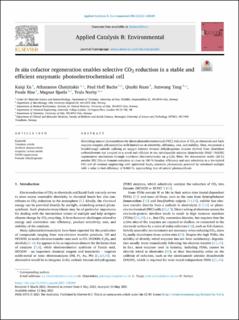In situ cofactor regeneration enables selective CO2 reduction in a stable and efficient enzymatic photoelectrochemical cell
Xu, Kaiqi; Chatzitakis, Athanasios Eleftherios; Backe, Paul Hoff; Ruan, Qiushi; Junwang, Tang; Rise, Frode; Bjørås, Magnar; Norby, Truls Eivind
Peer reviewed, Journal article
Published version

Åpne
Permanent lenke
https://hdl.handle.net/11250/2786412Utgivelsesdato
2021Metadata
Vis full innførselSamlinger
Originalversjon
Applied Catalysis B: Environmental. 2021, 296:120349 1-9. 10.1016/j.apcatb.2021.120349Sammendrag
Mimicking natural photosynthesis by direct photoelectrochemical (PEC) reduction of CO2 to chemicals and fuels requires complex cell assemblies with limitations in selectivity, efficiency, cost, and stability. Here, we present a breakthrough cathode utilizing an oxygen tolerant formate dehydrogenase enzyme derived from clostridium carboxidivorans and coupled to a novel and efficient in situ nicotinamide adenine dinucleotide (NAD+/NADH) regeneration mechanism through interfacial electrochemistry on g-C3N4 films. We demonstrate stable (20 h) aerobic PEC CO2-to-formate reduction at close to 100 % faradaic efficiency and unit selectivity in a bio-hybrid PEC cell of minimal engineering with optimized Ta3N5 nanotube photoanode powered by simulated sunlight with a solar to fuel efficiency of 0.063 %, approaching that of natural photosynthesis.
